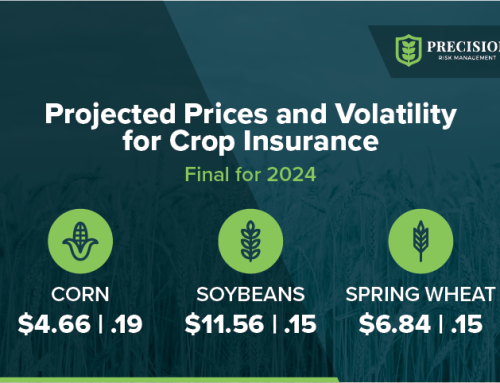Some of the country is receiving too much moisture/precipitation preventing growers from getting into fields to plant or causing issues for crop in the ground. There is still time to get the crop planted. PRM wants you to be prepared with information on Prevent Plant and Replant in case you need it. Hopefully, you will not need it.
Communication is the most important thing to a grower if they think they might have a Prevent Plant situation. Your Risk Management Advisor can help you through this period. Prevent Plant and Replant have many details and rules that could affect your specific operation and payment. Please keep your Advisor informed so they can help.
Prevent Plant
- Certain conditions prevented you from planting when needed such as too much rain or not enough rain
- The cause needs to be conditions affecting the general area (county) and not farm specific
- Must be at least 20 acres or 20% of the crop acreage unit, whichever is less
- The land must have been planted, insured, and harvested in one of the last four years
Important Dates
All important dates are specific to crop, county, and farming practices. You can look up your specific dates with this link or ask your Advisor.
Final Plant Date- This is the last day you can plant and still receive your full crop insurance guarantee.
Late Plant Period- The typical 25 day period a grower can plant after the Final Plant Date and still receive a reduced crop insurance guarantee. The guarantee will be reduced by 1% by each day.
How Much Will You Receive in a Prevent Plant Payment?
A Prevent Plant payment will be less than your Multi-Peril Crop Insurance Policy depending on what you selected during sign-up. Typically, it is around 55-60% of your guarantee per acre.
How Many of Your Acres are Eligible for Prevent Plant?
It is the highest insured acres in the last 4 years for the unit.
For example, if you planted and insured 400 acres of corn 2 years ago, your maximum potential Prevent Plant would be 400 acres. This year, you were able to plant 300 acres of corn. Your Prevent Plant eligibility would be 100 acres for this year.
400 max – 300 planted = 100 PP acres.
What Are Your Options After Taking Prevent Plant?
1. Take 100% of your Prevent Plant payment and do nothing else
2. Plant a second crop and receive 35% of your Prevent Plant payment. Your second crop will be eligible for multi-peril crop insurance indemnity payment if planted after the final plant date.
3. Plant forage as a cover crop. It can be hayed, grazed, or cut for silage at any time without affecting prevent plant payments.
4. Other options specific to your operation. Talk to your Advisor for more options
Process of Prevent Plant at PRM
You need to contact PRM within 72 hours after the Late Plant Period. PRM recommends contacting your Risk Management Advisor as early as possible.
Precision Risk Management makes PP as easy as possible. You can read our full process by clicking the link below.
Q & A on Prevent Plant
Can I plant corn as a cover crop?
– No. In accordance with the Special Provisions, corn is not considered a cover crop for crop insurance purposes and will be considered a crop planted for harvest.
I planted a cover crop during the late planting period of the crop for which I am claiming a prevented planting payment. Can I also enroll these acres in an NRCS program without impacting my prevented planting payment?
– Yes, these acres may be enrolled in an NRCS program, such as EQIP and maintain prevented planting coverage. Normal cover crop procedures would apply.
I am interested in planting a cover crop after the late planting period (for the crop I am receiving a prevented planting payment) to keep the ground covered for conservation purposes. I would also like to chop it for silage sometime in the fall. Will that affect my prevented planting payment?
– You may hay, graze, or cut the cover crop for silage, haylage, or baleage and your prevented planting payment will not be affected. Corn planted on acreage following a prevented planting claim will be considered planted for harvest.
Will this affect my APH?
-It depends what you do after receiving a Prevent Plant payment. If a second crop is planted and a 35% payment is collected, this year’s yield will be counted as 60% of the current Actual Production History (APH). If you collect a Prevent Plant payment and do not plant a second crop, no yield history is counted for that year and the APH is not affected for the following year.
Replant Policy
If you have already planted and think you need to replant, these are the main policy reminders. The key to Replant is to not take any actions without consent from Precision Risk Management. You may put your policy in jeopardy by proceeding without consent.
- Acres damaged by an insured cause
- Must have been planted on or after the earliest plant date
- PRM Adjuster must determine it is practical and qualifies for replant
- Must be at least 20 acres or 20% of the crop acreage, whichever is less
- The replanted crop must be the same as the initial input crop
Certification Process
Before replanting, certification needs to occur. Depending on the acres, you may be able to complete the certification yourself with the guidance of PRM.
If FEWER than 100 acres per unit: no PRM certification needed. PRM Adjuster will provide you process for self-certification.
If MORE than 100 acres per unit: PRM Adjuster will set up time to do on-farm certification.
Keep Your Advisor Up to Date With Your Plan
This is general information about Prevent Plant/Replant and does not go into the many details. Your Risk Management Advisor is your best resource and consultant how best to go forward with Prevent Plant/Replant and what comes next. Contact them directly or click the link below.






